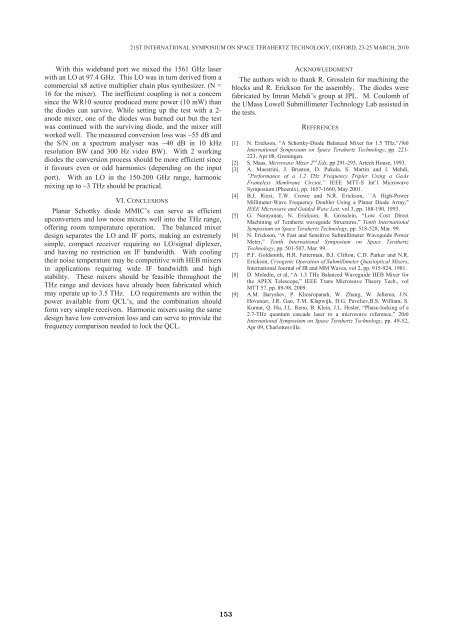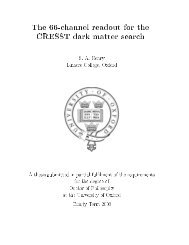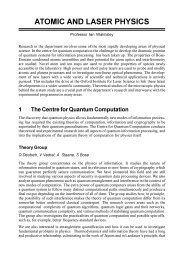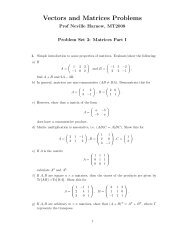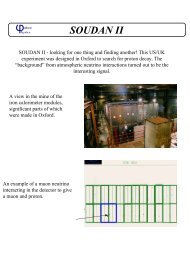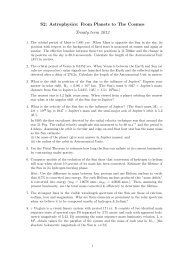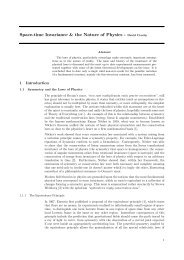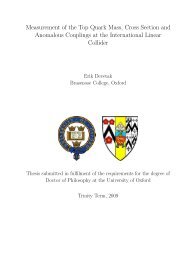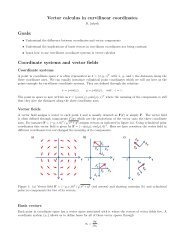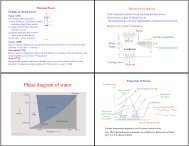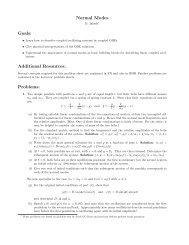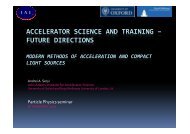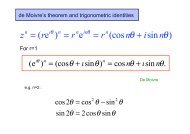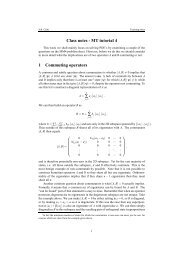Session S6: Schottky Diodes and Mixers - Department of Physics
Session S6: Schottky Diodes and Mixers - Department of Physics
Session S6: Schottky Diodes and Mixers - Department of Physics
Create successful ePaper yourself
Turn your PDF publications into a flip-book with our unique Google optimized e-Paper software.
21ST INTERNATIONAL SYMPOSIUM ON SPACE TERAHERTZ TECHNOLOGY, OXFORD, 23-25 MARCH, 2010<br />
With this wideb<strong>and</strong> port we mixed the 1561 GHz laser<br />
with an LO at 97.4 GHz. This LO was in turn derived from a<br />
commercial x8 active multiplier chain plus synthesizer. (N =<br />
16 for the mixer). The inefficient coupling is not a concern<br />
since the WR10 source produced more power (10 mW) than<br />
the diodes can survive. While setting up the test with a 2-<br />
anode mixer, one <strong>of</strong> the diodes was burned out but the test<br />
was continued with the surviving diode, <strong>and</strong> the mixer still<br />
worked well. The measured conversion loss was ~55 dB <strong>and</strong><br />
the S/N on a spectrum analyser was ~40 dB in 10 kHz<br />
resolution BW (<strong>and</strong> 300 Hz video BW). With 2 working<br />
diodes the conversion process should be more efficient since<br />
it favours even or odd harmonics (depending on the input<br />
port). With an LO in the 150-200 GHz range, harmonic<br />
mixing up to ~3 THz should be practical.<br />
VI. CONCLUSIONS<br />
Planar <strong>Schottky</strong> diode MMIC’s can serve as efficient<br />
upconverters <strong>and</strong> low noise mixers well into the THz range,<br />
<strong>of</strong>fering room temperature operation. The balanced mixer<br />
design separates the LO <strong>and</strong> IF ports, making an extremely<br />
simple, compact receiver requiring no LO/signal diplexer,<br />
<strong>and</strong> having no restriction on IF b<strong>and</strong>width. With cooling<br />
their noise temperature may be competitive with HEB mixers<br />
in applications requiring wide IF b<strong>and</strong>width <strong>and</strong> high<br />
stability. These mixers should be feasible throughout the<br />
THz range <strong>and</strong> devices have already been fabricated which<br />
may operate up to 3.5 THz. LO requirements are within the<br />
power available from QCL’s, <strong>and</strong> the combination should<br />
form very simple receivers. Harmonic mixers using the same<br />
design have low conversion loss <strong>and</strong> can serve to provide the<br />
frequency comparison needed to lock the QCL.<br />
ACKNOWLEDGMENT<br />
The authors wish to thank R. Grosslein for machining the<br />
blocks <strong>and</strong> R. Erickson for the assembly. The diodes were<br />
fabricated by Imran Mehdi’s group at JPL. M. Coulomb <strong>of</strong><br />
the UMass Lowell Submillimeter Technology Lab assisted in<br />
the tests.<br />
REFERENCES<br />
[1] N. Erickson, “A <strong>Schottky</strong>-Diode Balanced Mixer for 1.5 THz,”19th<br />
International Symposium on Space Terahertz Technology, pp. 221-<br />
223, Apr 08, Groningen.<br />
[2] S. Maas, Microwave Mixer 2 nd Eds, pp 291-293, Artech House, 1993.<br />
[3] A. Maestrini, J. Bruston, D. Pukala, S. Martin <strong>and</strong> I. Mehdi,<br />
“Performance <strong>of</strong> a 1.2 THz Frequency Tripler Using a GaAs<br />
Frameless Membrane Circuit,” IEEE MTT-S Int’l Microwave<br />
Symposium (Phoenix), pp. 1657-1660, May 2001.<br />
[4] B.J. Rizzi, T.W. Crowe <strong>and</strong> N.R. Erickson, ``A High-Power<br />
Millimeter-Wave Frequency Doubler Using a Planar Diode Array,"<br />
IEEE Microwave <strong>and</strong> Guided Wave Lett. vol 3, pp. 188-190, 1993.<br />
[5] G. Narayanan, N. Erickson, R. Grosslein, “Low Cost Direct<br />
Machining <strong>of</strong> Terahertz waveguide Structures,” Tenth International<br />
Symposium on Space Terahertz Technology, pp. 518-528, Mar. 99.<br />
[6] N. Erickson, “A Fast <strong>and</strong> Sensitive Submillimeter Waveguide Power<br />
Meter,” Tenth International Symposium on Space Terahertz<br />
Technology, pp. 501-507, Mar. 99.<br />
[7] P.F. Goldsmith, H.R. Fetterman, B.J. Clifton, C.D. Parker <strong>and</strong> N.R.<br />
Erickson, Cryogenic Operation <strong>of</strong> Submillimeter Quasioptical <strong>Mixers</strong>,<br />
International Journal <strong>of</strong> IR <strong>and</strong> MM Waves, vol 2, pp. 915-924, 1981.<br />
[8] D. Meledin, et al, “A 1.3 THz Balanced Waveguide HEB Mixer for<br />
the APEX Telescope,” IEEE Trans Microwave Theory Tech., vol<br />
MTT 57, pp. 89-98, 2009.<br />
[9] A.M. Baryshev, P. Khosropanah, W. Zhang, W. Jellema, J.N.<br />
Hovenier, J.R. Gao, T.M. Klapwijk, D.G. Paveliev,B.S. William, S.<br />
Kumar, Q. Hu, J.L. Reno, B. Klein, J.L. Hesler, “Phase-locking <strong>of</strong> a<br />
2.7-THz quantum cascade laser to a microwave reference,” 20th<br />
International Symposium on Space Terahertz Technology, pp. 49-52,<br />
Apr 09, Charlottesville.<br />
153


